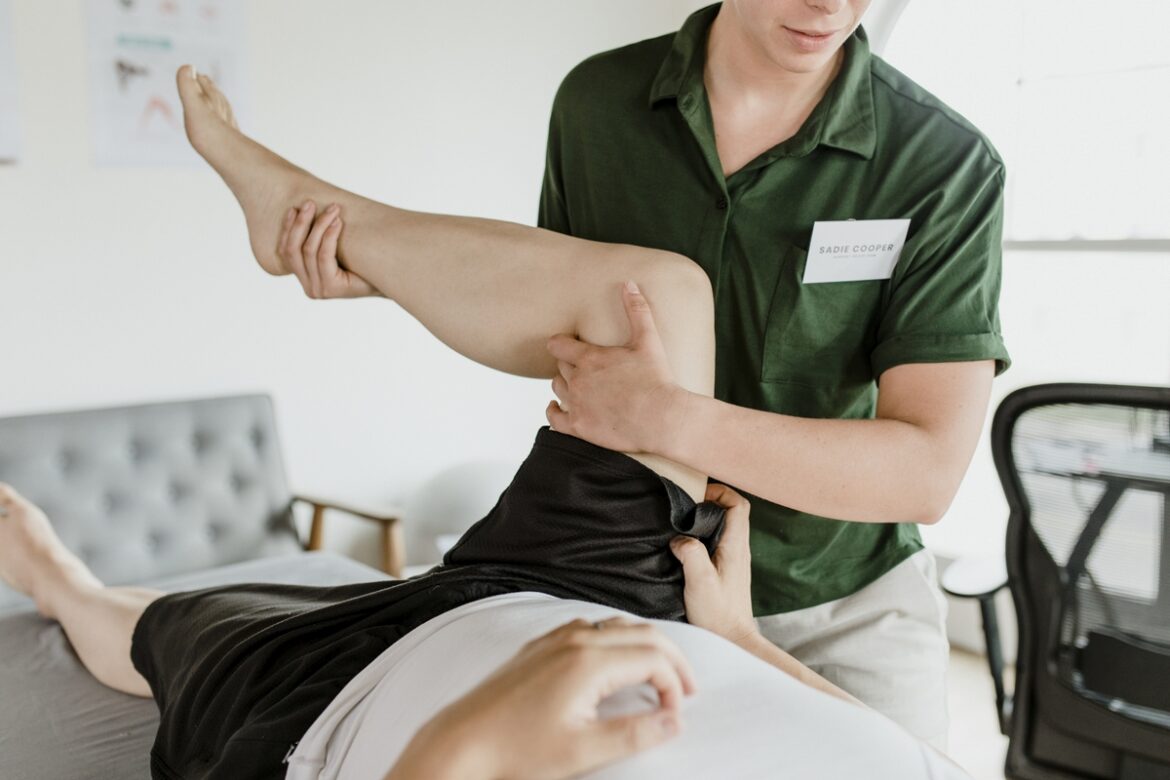
Knee Preservation: A Comprehensive Guide to Preventing MCL and ACL Injuries
Knees are remarkable joints, allowing us to run, jump, pivot, and move with grace. They are also vulnerable to injuries. Two of the most common being MCL (Medial Collateral Ligament) and ACL (Anterior Cruciate Ligament) tears. These injuries can be painful, debilitating, and often require extensive rehabilitation. The good news is that many MCL and ACL injuries are preventable through targeted exercises and mindful practices.
In this comprehensive guide, we will investigate the world of injury prevention. Understand the anatomy of the knee and the risk factors for MCL and ACL injuries. We will also learn a range of preventive measures, including exercises, techniques, and strategies to help you safeguard your knees and continue enjoying an active lifestyle.
Understanding the Knee: Anatomy and Function
Before we get into prevention strategies, let us understand the knee’s intricate anatomy and how it functions. The knee is a hinge joint that connects the thigh bone (femur) to the shin bone (tibia). Two crucial ligaments, the MCL and ACL. These ligaments play a pivotal role in stabilizing the knee:
Medial Collateral Ligament (MCL): This ligament runs along the inner side of the knee and helps prevent excessive side-to-side movement. It acts as a stabilizer and protector of the inner knee joint.
Anterior Cruciate Ligament (ACL): Positioned deep within the knee joint, the ACL prevents the shin bone from moving too far forward or rotating too much. It is crucial for controlling the knee’s rotational stability.
Understanding the specific functions of these ligaments is essential in comprehending how to prevent injuries to them.
Risk Factors for MCL and ACL Injuries
Several factors increase the risk of MCL and ACL injuries:
Sports and Physical Activities: Athletes participating in sports that involve sudden stops, pivoting, or jumping, such as soccer, basketball, and skiing, are at higher risk. These activities place significant stress on the knee ligaments.
Gender: Female athletes are more susceptible to ACL injuries due to differences in biomechanics and hormonal factors. These differences can affect the alignment of the knee joint, making it more vulnerable.
Previous Injuries: A history of knee injuries, including MCL or ACL tears, increases the likelihood of re-injury. This is because prior injuries can weaken the ligaments and surrounding structures.
Muscle Imbalances: Weakness or imbalances in the muscles surrounding the knee can compromise stability. The quadriceps, hamstrings, and calf muscles play a crucial role in supporting the knee joint.
Now that we understand the knee’s structure and the risk factors involved, let us explore the preventive measures that can help protect your knees.

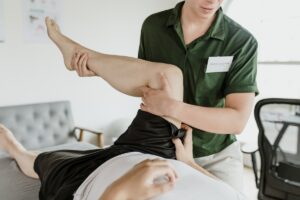
Health wellness massage training course
Injury Prevention Strategies
- Strength Training
One of the most effective ways to prevent knee injuries is by building strength in the muscles that support the knee joint. When these muscles are strong, they provide better stability and protection for the ligaments.
Exercises to consider:
Squats: Squats are a compound exercise that targets the quadriceps, hamstrings, and glutes. Proper squatting technique is essential to avoid knee strain.
Lunges: Lunges work the quadriceps, hamstrings, and glutes while also improving balance. Variations include forward reverse, and lateral lunges.
Leg Presses: Leg presses primarily target the quadriceps and can be a valuable addition to your strength training routine.
Calf Raises: Strong calf muscles help stabilize the ankle and indirectly support the knee. Calf raises can be performed on a step or flat ground.
Hip Abduction and Adduction Exercises: Strengthening the hip muscles is crucial for knee stability. Hip abduction exercises (e.g., side leg lifts) and adduction exercises (e.g., clamshells) can help.
- Balance and Proprioception
Balancing exercises help improve proprioception, which is your body’s sense of where it is in space. Enhanced proprioception can help you react better to sudden changes in terrain or direction.
Exercises to consider:
Single-leg Balance Exercises: Stand on one leg with your eyes open and then closed. Challenge yourself by adding movements like swinging your free leg or tossing a ball.
Wobble Board Drills: Using a wobble board or balance disc challenges your balance and engages the stabilizing muscles around the knee.
Stability Ball Exercises: Performing exercises like planks or bridges with your feet on a stability ball adds an element of instability, requiring you to engage your core and leg muscles for balance.
- Agility Training
Agility drills mimic the dynamic movements often seen in sports and help condition your body to manage sudden directional changes.
Exercises to consider:
Cone Drills: Set up a series of cones and weave through them at varying speeds. This drill improves lateral movement and quick changes in direction.
Ladder Drills: Agility ladder drills improve footwork, coordination, and the ability to make precise movements.
Shuttle Runs: Shuttle runs involve sprinting back and forth between two points, evaluating your ability to accelerate, decelerate, and change direction rapidly.
- Plyometric Training
Plyometric exercises focus on explosive movements that improve neuromuscular control. This is a crucial factor in ACL injury prevention.
Exercises to consider:
Box Jumps: Stand in front of a sturdy box or platform and jump onto it from a squat position. This exercise helps improve power and coordination.
Squat Jumps: Begin with a squat and explosively jump upward. Land softly with a slight bend in your knees.
Lateral Jumps: Jump laterally from side to side, landing softly on each leg. This exercise enhances lateral stability and agility.
- Stretching and Flexibility
It is important to maintain good flexibility in the muscles and ligaments around the knee. This is vital to reducing the risk of injury.
Exercises to consider:
Quadriceps and Hamstring Stretches: Stretching the quadriceps and hamstrings can help maintain good knee flexibility. Examples include the standing quad stretch and seated hamstring stretch.
Calf Stretches: Tight calf muscles can affect the alignment of the knee joint. Stretch the calf muscles by pressing the heel into the ground while keeping the knee straight.
Hip Flexor Stretches: Flexible hip flexors can contribute to better overall lower body mobility. The kneeling hip flexor stretch is effective for this purpose.
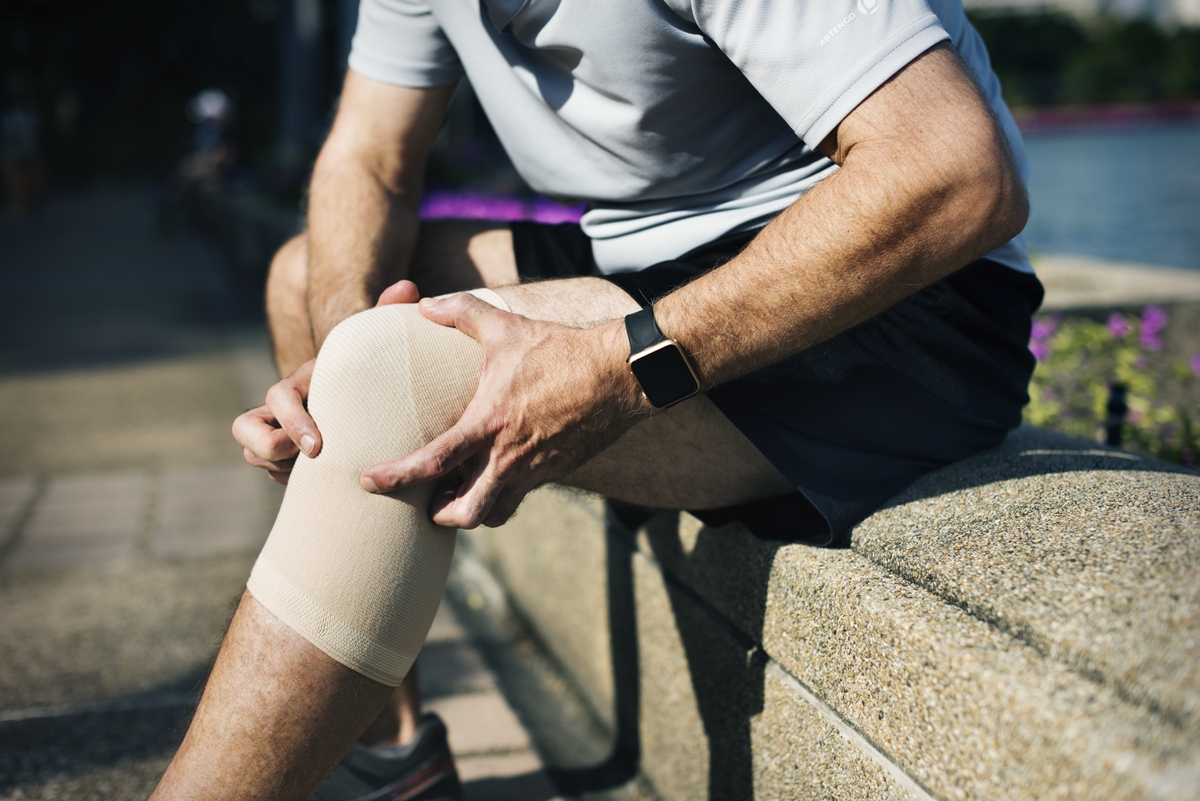
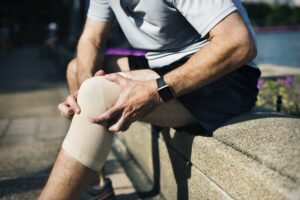
Elderly man having a knee injury
- Proper Landing Techniques
Learning how to land safely from jumps. The landing of the body is particularly important in sports where these movements are common.
Techniques to remember:
Bend Your Knees Upon Landing: Whether you are coming down from a jump or making a quick stop, always land with your knees slightly bent. This helps absorb the impact and reduces stress on the ligaments.
Maintain Proper Body Alignment: Keep your knees in line with your hips and feet when landing. Avoid letting your knees collapse inward (valgus collapse), as this can strain the ACL.
Engage Core Muscles to Absorb Shock: A strong core helps absorb the shock of landing. Keep your core engaged and your torso stable.
- Core Strengthening
A strong core provides stability and support to the lower body. It helps to protect the knees during physical activities.
Exercises to consider:
Planks: Planks are a staple core exercise that also engages the muscles around the hips and lower back. Maintain a straight line from head to heels.
Bridges: Bridges target the glutes and lower back muscles, helping to support the pelvis and lower body.
Russian Twists: This exercise strengthens the obliques, which play a role in rotational stability.
- Warm-Up and Cool-Down
Properly warming up before physical activity and cooling down afterward can prepare your muscles and ligaments for exercise and aid in recovery.
Warm-up activities:
Light Jogging: A few minutes of light jogging or brisk walking increases blood flow to the muscles and raises your body temperature.
Dynamic Stretching: Dynamic stretches involve controlled movements that mimic the activity you are about to perform. Examples include leg swings and arm circles.
Mobility Exercises: Include exercises that improve joint mobility, such as ankle circles and hip rotations.
Cool-down activities:
Static Stretching: After your workout, perform static stretches to lengthen and relax the muscles. Hold each stretch for 15-30 seconds.
Foam Rolling: Using a foam roller can help release muscle tension and improve circulation. Focus on areas that feel tight or sore.
- Proper Technique
Coaches and trainers should emphasize proper technique and body mechanics during sports and activities to reduce the risk of ACL and MCL injuries. Athletes should receive guidance on how to execute movements safely. Movements such as jumping, pivoting, and cutting are considered high risk.
- Footwear and Equipment
Wearing appropriate footwear and protective gear can also play a role in injury prevention. Footwear with good arch support and traction can help reduce the risk of slips and falls. In certain sports, such as skiing or snowboarding, wearing protective knee braces or guards may be advisable.
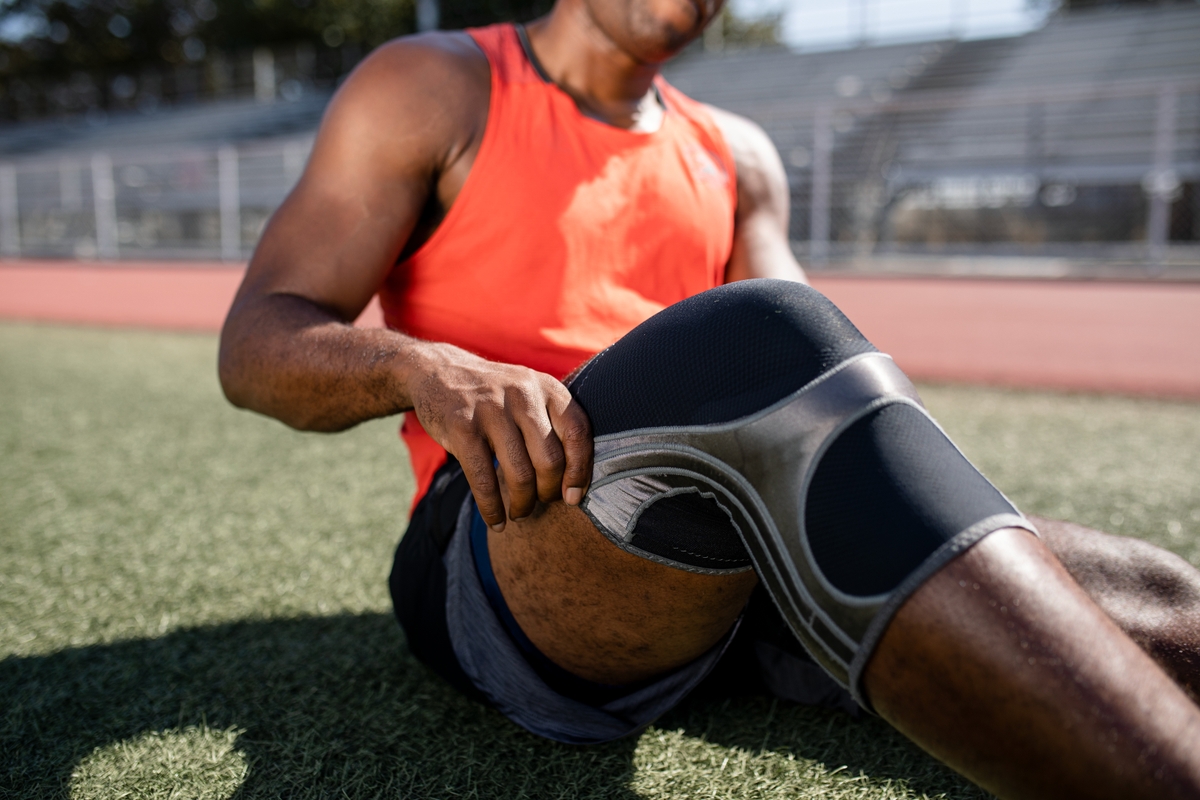
Tailoring Prevention to Your Needs
It is essential to tailor your preventive measures to your individual needs. If you have a history of knee injuries or specific risk factors, consider consulting with a physical therapist or sports medicine specialist. They can provide personalized guidance, recommend specific exercises, and assess your movement patterns to identify areas of improvement.
It is crucial to incorporate these preventive strategies into your regular fitness routine consistently. Make injury prevention an ongoing commitment to ensure the long-term health and functionality of your knees.
At what age should you start the preventive measures?
The age at which an athlete should start incorporating preventive measures for their knees can vary depending on several factors. One major factor is the individual’s sport. The second consideration is the physical development of the person. It is generally advisable to begin preventive measures early in an athlete’s career. Here are some guidelines to consider.
Youth Athletes (Under 12 years old): It is never too early to start promoting good movement patterns, proper technique, and overall physical fitness. Formal strength training may not be appropriate at young ages. Focus on fundamental movements, balance, and coordination. This will lay a strong foundation for knee health. Youth sports programs should prioritize skill development, safety, and age-appropriate training.
Adolescent Athletes (12 to 18 years old): This is a crucial age range to introduce structured injury prevention programs. Young athletes go through growth spurts and increased sports participation at different times. They will become more susceptible to knee injuries as they move through these states. Incorporating exercises that improve strength, flexibility, and neuromuscular control can significantly reduce the risk of injuries like ACL tears. Coaches, parents, and trainers should take initiative-taking in implementing these programs.
College and Adult Athletes (18+ years old): For athletes in this age group, injury prevention should be an ongoing and integral part of their training. Many college and professional sports programs have dedicated strength and conditioning coaches who implement comprehensive injury prevention protocols. Adult athletes should continue to focus on strength, agility, and flexibility, while also paying attention to proper technique and recovery.
Master’s Athletes (35+ years old): As athletes age, the risk of injury may increase due to factors like decreased muscle mass and flexibility. Injury prevention remains important. Athletes should adapt their training to account for age-related changes. This may include more emphasis on flexibility, joint mobility, and recovery strategies.
Individual Variation: It is important to recognize that athletes develop at different rates and have varying needs. Some young athletes may require more extensive injury prevention measures due to their sport or personal factors. Other athletes may need less attention. The key is to tailor preventive measures to the individual’s needs. Take all known factors into account like injury history, sport demands, and physical condition.
Final Thought
Protecting your knees from MCL and ACL injuries is crucial for maintaining an active and pain-free lifestyle. By incorporating a combination of strength training, balance exercises, agility drills, and proper techniques into your fitness routine, you can significantly reduce your risk of these debilitating injuries. Prevention is key, and an initiative-taking approach to knee health will allow you to continue enjoying the activities you love while keeping your knees strong and resilient for years to come. Your knees are the foundation of your mobility. Treat them with care and diligence.
